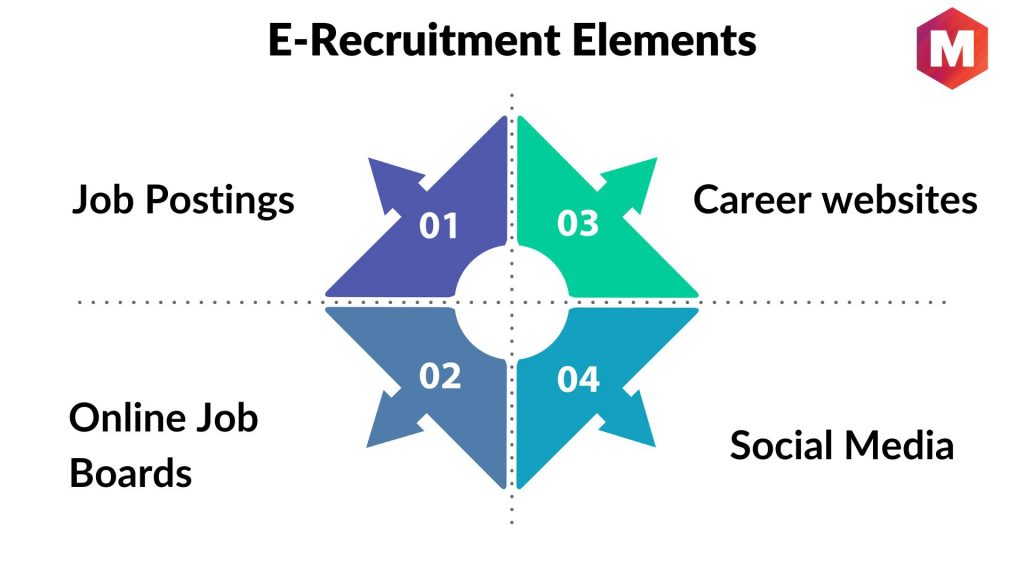Table of Contents
What is e-recruitment?
E-recruitment is an online recruitment process that involves various procedures of attracting, evaluating, selecting, recruiting, and onboarding job prospects. It is also known as e-staffing, e-resourcing, or e-hiring process. This process uses a variety of tools to communicate with job seekers, such as e-mail, online job boards, and career websites.
E-recruitment is the process of recruiting candidates online. This can be done through job boards, career websites, or social media platforms. e-recruitment allows employers to reach a larger pool of candidates and makes the recruitment process more efficient.
There are several advantages to online recruitment. First, it saves time and money by eliminating the need to post job advertisements in newspapers or other traditional channels. Second, it makes it easier to target specific groups of candidates. For example, employers can use it to search for candidates with particular skills or experience. Finally, it allows employers to track the progress of their recruitment campaigns and assess the performance of different recruiting channels.
The goal of online recruitment methods is to find the best talent for a company quickly and efficiently. It can be used for all types of positions, from entry-level jobs to executive positions. It is especially useful for companies and HR managers that are looking to hire large numbers of employees, such as in the case of a mass layoff.
E-recruitment Elements
There are four main elements of the e-recruiting process used by recruitment agencies and hr managers:
1. Job postings
Job postings are the most common form of e-recruitment. They are advertisements that list the requirements for a position and provide instructions on how to apply.
2. Online job boards
Online job boards are websites that list job postings from multiple companies. Job seekers can search for positions by keyword, location, or job type.
3. Career websites
Career websites are websites that are specific to one company. They often include job postings, as well as information about the company culture and benefits.
4. Social media
Social media platforms, such as LinkedIn and Twitter, can be used for e-recruitment. Employers can post job openings on their social media platforms and job seekers can search for positions using keywords.
Steps in an e-Recruitment Process
There are several steps in the e-recruitment process:
1. Developing job postings
The first step is to develop job postings that accurately reflect the duties, responsibilities, and qualifications required for the position.
2. Posting job openings
The next step is to post the job openings on online job boards, career websites, and social media platforms.
3. Screening job applicants
The next step is to screen job applicants to identify the most qualified candidates. This can be done through an automated system that assesses resumes, cover letters, and job applications.
4. Conducting interviews
The next step is to conduct interviews with the most qualified candidates. This can be done through video conferencing, phone calls, or in-person meetings.
5. Making job offers
The final step is to make job offers to the most qualified candidates. This can be done via e-mail, phone call, or in-person meeting.
The e-recruitment process is an efficient way to find the best talent for a company. It saves time and money by eliminating the need to post job advertisements in newspapers or other traditional channels.
Additionally, e-recruitment makes it easier to target specific groups of candidates. For example, employers can use e-recruitment to search for candidates with particular skills or experience. Finally, e-recruitment allows employers to track the progress of their recruitment campaigns and assess the performance of different recruiting channels.
Types of E-Recruitment Methods
1. Sourcing potential candidates
The first step in e-recruitment is sourcing potential candidates. This can be done through online job boards, career websites, social media platforms, and employee referral programs.
2. Using ATS or Applicant Tracking System
The second step is to use an applicant tracking system (ATS) to screen job applicants. ATS is software that helps employers manage job postings, resumes, and cover letters.
3. Conducting online/video job interviews
The third step is to conduct video interviews with the most qualified candidates. This can be done through Skype, Google Hangouts, or other video conferencing platforms.
4. Trying online testing
It is done through a survey and questionnaire. This step is used to further assess the skills and qualifications of candidates. Online tests can be used to measure aptitude, personality, and knowledge.
5. Creating job boards
Recruiters can create their own job boards to post job online and receive applications from candidates. This is a good way to reach a large number of potential candidates.
6. Using e-mail campaigns
The final step is to use e-mail campaigns to reach potential candidates. Recruiters can send e-mails with job postings to lists of subscribers. This is a good way to reach a large number of potential candidates.
Advantages of e-recruitment
1. Cost-effective
E-recruitment is a cost-effective way to find the best talent for a company while hiring candidates. It saves time and money by eliminating the need to post job advertisements in newspapers or other traditional channels.
2. Customized filtration
Additionally, e-recruitment makes it easier to target specific groups of candidates. For example, employers can use e-recruitment to search for candidates with particular skills or experience.
3. Quicker process
E-recruitment is a quicker process than traditional recruitment methods. It allows employers to post job openings and receive applications from candidates within a matter of days as e-recruitment systems speed is quite fast.
4. Flexible
E-recruitment is a flexible recruitment method that can be tailored to the specific needs of a company. For example, e-recruitment can be used to fill entry-level positions or senior executive positions.
Disadvantages of e-recruitment
There are some disadvantages of e-recruitment that should be considered before implementing this recruitment method.
1. Limited reach
One of the main disadvantages of e-recruitment is that it has a limited reach. E-recruitment only reaches candidates who have access to the internet and are actively searching for job openings.
2. Lack of personal interaction
One of the main disadvantages of e-recruitment is that it lacks the personal interaction of traditional recruitment methods. E-recruitment relies heavily on computerized systems and automated processes.
3. Increased competition:
Another disadvantage of e-recruitment is that it increases competition for jobs. With more employers using e-recruitment, candidates must compete against a larger pool of applicants.
4. Security risks
One of the main disadvantages of e-recruitment is that it poses some security risks. For example, e-recruitment systems can be hacked and personal information can be stolen.
5. Technical difficulties
Another disadvantage of e-recruitment is that it can be difficult to use. E-recruitment systems can be complicated and difficult to navigate.
Despite these disadvantages, e-recruitment is a popular recruitment method that offers many advantages over traditional recruitment methods. So, it is one of the most preferred ways of modern recruitment methods.
Sourcing potential candidates
Some of the ways through which potential candidates are sourced in e-recruiting are
1. Applicant tracking system (ATS)
An applicant tracking system (ATS) is a software application that helps employers post job openings and receive applications from candidates. ATS systems are used by recruiters to track and manage job applications.
2. Interviewing candidates online
Another way to source potential candidates is to interview them online. This can be done using video conferencing tools like Skype or Google Hangouts. Online interviews allow employers to screen candidates from anywhere in the world.
3. Online testing
Online testing is another way to source potential candidates. Employers can use online tests to assess a candidate’s skills and abilities. Online tests are a convenient and cost-effective way to screen candidates.
4. Job boards
Job boards are another popular way to find potential candidates. Job boards are websites that list job openings from employers. Candidates can search for job openings and apply for positions online.
Top E-recruitment Software
The following are some of the top e-recruiting software vendors that make recruiting an effective automated process for hiring ideal candidates-
1. Jobvite
Jobvite is a popular e-recruitment system that helps employers post job openings and receive applications from candidates. It’s a recruitment software and applicant tracking platform that aids thousands of businesses in finding, recruiting, and onboarding great employees.
2. Recruitee
Recruitee is a user-friendly recruitment software that allows you to set up a career website, manage job offers and candidates, simplify the work of staff, and measure HR performance. Recruitee offers a recruiting automation and optimization solution that helps businesses attract the best talent by automating and optimizing their recruitment efforts.
3. Workable
Workable is an electronic recruitment system that allows businesses to post job opportunities and receive applications from potential employees. It also offers tools to help you screen and rate candidates, schedule interviews, and track your hiring progress.
4. Greenhouse
It is a cloud-based multi-faceted e-recruiting solution that includes an Application Tracking System (ATS), Candidate Relationship Management (CRM) system, and much more. This hr software helps an hr manager to optimize their recruiting process and improve their hiring outcomes during job opening, job description, job profile shortlisting, and other online stages of online recruitment processes.
5. JobAdder
The JobAdder recruitment management software is a cloud-based platform for staffing firms and in-house corporate human resource departments. The solution may be used from any internet-connected device using a web browser. Recruiters may use JobAdder to manage job orders, match applications to occupations, and keep track of prospects’ development. The e-recruitment system offers client and candidate portals and an iOS app.
6. iCIMS
TalentCloud is a leading provider of talent acquisition and management solutions for Fortune 500 businesses. It empowers organizations to attract, engage, recruit, and develop superior employees by providing them with a cloud-based suite of HR services.
7. eQuest
eQuest is a global provider of applicant tracking and recruitment marketing solutions. eQuest’s job posting products and services help customers reach the largest audience of job seekers. eQuest’s analytics help customers make data-driven decisions to improve their recruiting process.
8. SmartRecruiters
SmartRecruiters is a cloud-based recruiting platform that helps businesses find, hire, and onboard the right talent. The e-recruitment system offers a variety of features, including job postings, candidate tracking, and interview scheduling.
9. JazzHR
JazzHR is a cloud-based e-recruitment system that helps businesses automate their recruiting process. The solution offers features such as job postings, candidate application process tracking, and interview scheduling.
10. Zoho Recruit
Zoho Recruit is an e-recruitment system that helps businesses automate their recruiting process. The solution offers features such as job postings, candidate tracking, and interview scheduling. Zoho Recruit also offers a mobile app that allows recruiters to manage their recruitment process on the go.
Conclusion!
E-recruitment is an excellent way to find top talent. By using e-recruitment tools and platforms, companies can reach a wider pool of candidates, screen applicants more efficiently, and save time and money. e-recruitment can also help you target specific groups of people, such as recent graduates or experienced professionals.
If you’re looking for a new job, e-recruitment is a great option. There are many e-recruitment platforms and websites, so you can find one that suits your needs. You can also use e-recruitment to research companies and find out more about the job market.
If you’re an employer, e-recruitment can help you find the best candidates for your vacancy.
Recent Statistics and Industry Insights on E-recruitment
Did you know? According to a recent survey by the Society for Human Resource Management (SHRM), over 80% of organizations are now utilizing e-recruitment methods as a primary tool for hiring, highlighting the significant shift towards digital platforms in talent acquisition.
Industry Insight: The integration of artificial intelligence in e-recruitment is accelerating. A 2023 report by Gartner indicates that companies adopting AI-powered recruiting tools can reduce time-to-hire by up to 30%, enhancing efficiency and improving candidate experience.
Liked this post? Check out the complete series on Human resources


